
Discover how your KitKat break is aiding change

Enjoy A Better Break
We at KitKat are on a mission to go even further with our support of cocoa farmers, their families, and the local environment too. Cue: the Income Accelerator programme.
As we start to use cocoa from the programme across our products, you’ll see messaging to highlight this on some of our range from 2023, with the roll out to more products in 2024.

Have a Break for Good
To make your favourite KitKat even better, we have set ourselves the mission to go further with our support of cocoa farmers, their families, and the local environment too. That’s what the innovative income accelerator program is all about. This program takes an innovative family-centred approach that aims to close the living income gap and improve the livelihoods of cocoa farmers within our supply chain.
Our journey began back in 2009 when the Nestlé Cocoa Plan was born, and we have learnt a lot along the way (you can find out more about the Nestlé Cocoa Plan here!). The income accelerator program builds on these learnings and focuses on initiatives that have already been proven to make a difference to cocoa-farming families’ lives. The program is built and designed to encourage changes in behaviour and reward positive practices – both within the home and on the farm. It incentivizes these families to take actions that improve cocoa productivity, plant forest and fruit trees, diversify their income and support kids’ education. Our program takes the unique approach of putting the families at the very heart of it, rather than just the individual farmers. By looking at the family, we’re placing greater value on women as agents for positive change.
Just like the four fingers of a KitKat, we have four pillars that bring this program to life. These pillars are based around four positive actions we incentivize cocoa-farming families to take. If all are achieved, cocoa-farming families can earn up to 500 euros in extra income a year in the first two years:
- Helping their children, aged 6 – 16, with schooling
- Improving the way farming is done, such as by effectively pruning trees, to increase crop productivity
- Planting forest and fruit trees on cocoa farms.This provides much-needed shade for the cocoa, helping resist the impact of climate change and supports biodiversity and potentially adds income for the farmers
- Empowering women to start businesses and diversify sources of income
These incentives in our income accelerator program aim to further secure cocoa-farming families’ well-being and are paid out equally between both heads of the household, directly into their hands via mobile payment. And these incentives are regardless of farm size, so even those with the smallest of farms can earn incentives, ensuring that no farmer is left behind. This support is given in addition to the Nestlé Cocoa Plan and the premium paid for certified Rainforest Alliance cocoa
So far, the program has been rolled out to 10,000 cocoa-farming families (and counting) in Côte d’Ivoire. It doesn’t stop there though! This is a step on the road to expand the program’s reach first in Côte d’Ivoire and Ghana and then aiming to reach 160,000 cocoa-farming families in our supply chain by 2030.
Visit each of the pages below to learn more about how we’re supporting farming families through the different pillars of the programme:
More Money For Cocoa Farming Families

More Power For Women
We're helping women gain more control over their money, families and communities. And through this, addressing wider gender inequality in Côte d'Ivoire.

Women On A Mission
The income accelerator program isn’t just about growing cocoa – we want people to flourish too. And it’s a universal truth that when women have a more active role in their society, everyone is better off.
In cocoa-farming communities, it’s still common for women to be completely financially dependent on their husbands. And unfortunately, there’s a wider gender equality imbalance that influences this. If women had the power to make decisions and support their families with secondary income, it wouldn’t just fortify households – it would also play a big part in tackling child labour.

So, here’s another way each Break for Good helps us supportthe 10,000 cocoa-farming families in Côte d’Ivoire. We’re empowering women in these communities with more opportunities to succeed.
We’re taking a holistic approach that falls into two main pillars: splitting incentives equally between the heads of each household, and providing training in gender equality and income diversification. We know, that’s a lot of long words.

Split Income 50/50
To promote women’s financial autonomy, the incentives from the income accelerator program are split 50-50 between both heads of the household. The women’s percentage is sent to her directly via secure mobile transfer.
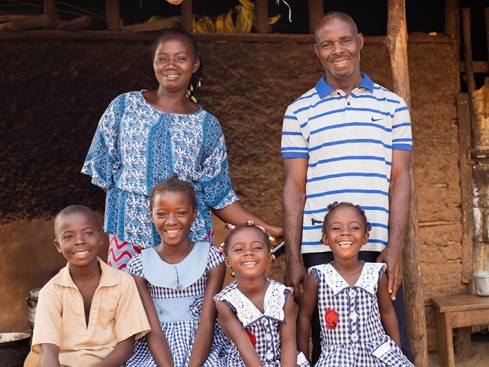
The aim? To encourage gender equality, help partners share financial responsibilities and ultimately build more resilient households.

IAP Modal Image - Women Training
We’re training women to start small businesses or activities that bring in a second income for the family. These include beekeeping, raising livestock such as chickens, and selling vegetables from community-led gardens.
The income accelerator program then distributes a €100 incentive for diversifying incomes – a great launchpad for developing a new business idea. And these, again, are securely sent directly to the women.
But gender justice isn’t just a women’s issue. Employing the Gender Action Learning System methodology, we’re training women and men to recognise that they can achieve more and live a better life if they work together. A woman can farm. A man can help around the house. And together, they can make sure their kids are safe, fed, loved and educated.
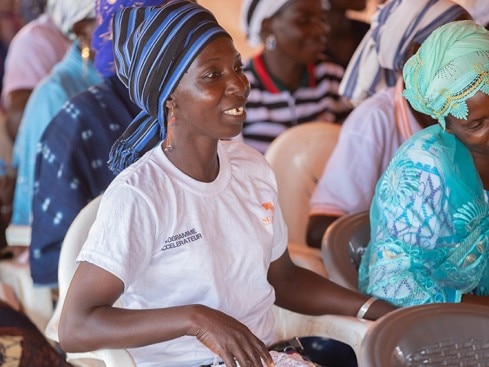
We’ve also been helping set up Village Savings and Loans Associations within communities. Self-managed and selfcapitalised, these woman-focused schemes encourage saving, and provide loans for small business opportunities. With financial barriers broken down and self-confidence boosted, women can become changemakers in their communities.
Here’s to new opportunities!
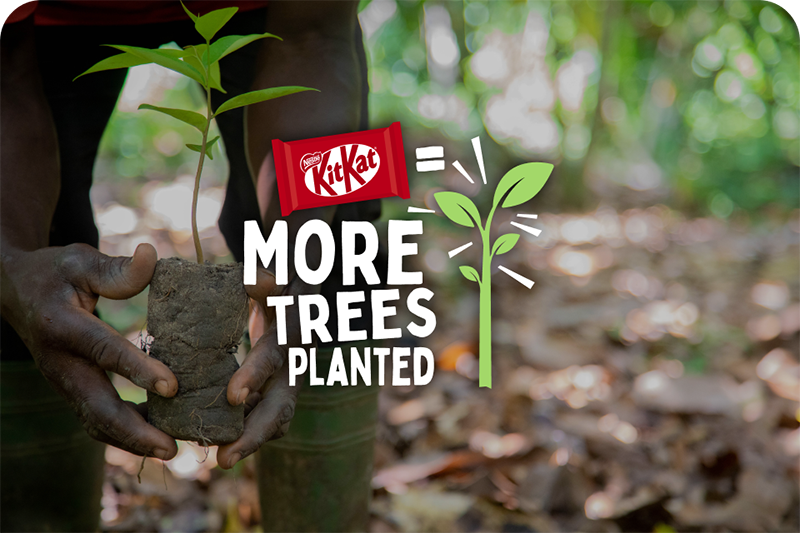
Cocoa trees also love company
You’re here because you’ve scanned the unique QR code on your KitKat (or maybe you just Googled it).
Well, we’re glad you did because now we can tell you all about the good your break is helping to do!
See that KitKat you’re currently munching on?
It’s part of an innovative program that, among other things, allocates forest and fruit trees to the cocoa-farming families in Côte d’Ivoire and incentivises them for planting and maintaining the trees.
By rewarding the families for positive agricultural practices, it not only increases their income, but also benefits the local environment and their community.

Before we go into the roots...
Let’s talk about what we have achieved so far. In 2022 alone, the Nestle Cocoa Plan distributed over 1 million fruit and forest trees. That’s six zeros!
These trees went directly to the cocoa farmers we work with in Côte d’Ivoire. We wanted to build on this with the income accelerator program and plant even more trees.
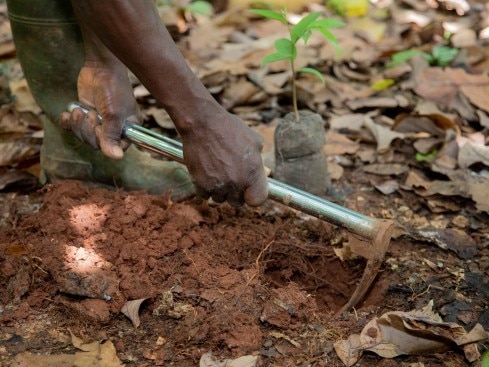
Why is this so important, you may ask?
Well, additional fruit and forest trees provide much needed shade for the cocoa trees, reducing the impact of climate change.
What’s more, planting a varied range of trees helps support the biodiversity of the area, improves soil health and in turn support the local ecosystem. So you could say, they are literally good company to the cocoa.

So how does it work within the income accelerator?
We incentivise farmers to plant a minimum of 10 trees on one hectare in the first year. Like our chocolate bars, the process is neatly wrapped up. We deliver the trees to the cocoa farms, and once they’re planted, the incentive is delivered directly in the hands of the cocoa-farming family through mobile payment.
Even better, these incentives are the same regardless of farm size, so even those with the smallest of farms can earn, ensuring that no farmer is left behind. Our involvement doesn’t stop once the trees are planted. With the support of our partners, we check in on the trees to make sure they are growing and thriving.

How many more trees have been planted within the income accelerator?
We aimed to plant 100,000 trees in year one, but we’ve already planted over 200,000.
We plan to keep this number growing and growing – like our trees – with our ambition to plant another 300,000 trees in the next year. We believe that the more forest and fruit trees that are planted, the better it will be for cocoa farmers, their families and of course, the cocoa too.
So far, we are working with 10,000 cocoa-farming families (and counting) in Côte d’Ivoire through the income accelerator program. And it doesn’t stop there, this is a step on the road to expand the program’s reach to Ghana and actively work to help 160,000 cocoa-farming families by 2030.

Helping Kids Break into Education
You’re here because you’ve scanned the unique QR code on your KitKat (or maybe you just Googled it).
Well, we’re glad you did because now we can tell you all about the good your break is helping to do!
See that KitKat you’re currently munching on?
It’s part of an innovative program that increases income for cocoa-farming families in Côte d’Ivoire and supports their kids going to school. The income accelerator programme takes a unique, family-centred approach, with the ambition to deliver real and long-lasting impact to cocoa-farming families’ lives and futures. This innovative programme rewards the families for taking actions that not only help them increase their income, but also benefit the local environment and their community.

All parents hope for a brighter future for their kids, which ultimately starts with an education.
We want to support cocoafarming families’ kids to keep learning in school– or, in some cases, just get started.
We’ve learned a lot from the Nestlé Cocoa Plan which, since 2012, has helped protect 156,974 from the risk of child labour. The income accelerator programme now goes even further by incentivising families to enrol their kids in school, so we can make sure that the cost of schooling is no longer a major barrier to children’s education.
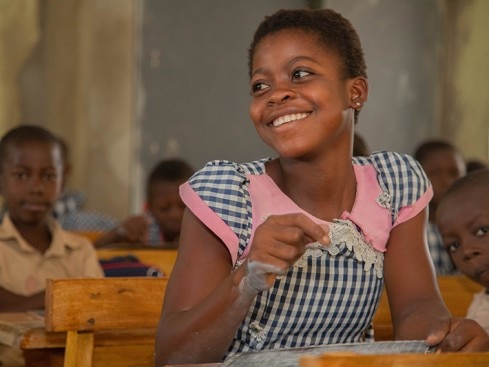
Within the income accelerator programme, cocoa farming-families can earn up to €100 for sending their kids to school. 50% of this is paid upfront, upon commitment from the parents to enrol their kids. The remaining 50% is paid, once it has been confirmed that their kids have been attending school regularly.
That’s it. And best of all, we pay this incentive directly in the hands of cocoafarming families, through mobile phone payments. It’s simple, it’s transparent and quick. We also support the kids by making sure they have what they need at school, such as providing school kits of stationery, pencils and books and school canteen subsidies.

By incentivising school attendance, we’re aiming to help many more kids kickstart their education.
So far, the program has been rolled out to 10,000 cocoafarming families (and counting) in Côte d’Ivoire.
It doesn’t stop there though! This is a step on the road to expand the program’s reach first in Côte d’Ivoire and Ghana and then aiming to reach 160,000 cocoa-farming families in our supply chain by 2030.

It is time to let you in on a secret…
Contrary to what you might think, cocoa pods aren't just a one-stop-shop for chocolate. They're transformed into several delicious ingredients that play an important role in your chocolate bar. They're the source of cocoa butter, cocoa powder, cocoa nibs and cocoa mass.
To make it a little easier to understand, check out the snappy visual we have below...

Our ambition behind sustainably sourced cocoa
Our story begins with sustainably sourced cocoa, the most delicious ingredient in our KitKat® bars. But wait a minute, what does it actually mean?
Let’s break it down from the moment the cocoa pod starts growing on the tree to the final bite of your chocolate treat.
Since the Nestlé® Cocoa Plan was launched in 2009, we’ve been working in collaboration with cocoa-farming families to implement practices that aim to improve livelihoods in cocoa-farming communities. This includes practices such as helping cocoa farmers improve yields and quality through training and resources, as well as helping communities thrive by empowering women and promoting greater access to education.
KitKat® was the first global brand at Nestlé® to source all its cocoa from the Nestlé Cocoa Plan including certified farms*. This was the first step and paved the way for our sustainable cocoa supply chain today. But before going into more details, let’s focus on the cocoa pod.
* Cocoa sourced through the Nestlé Cocoa Plan includes volumes of Rainforest Alliance certified cocoa and Nestlé Cocoa Plan verified mass balance. Mass balance means that we purchased a volume of certified cocoa equivalent to the volume used in the product.
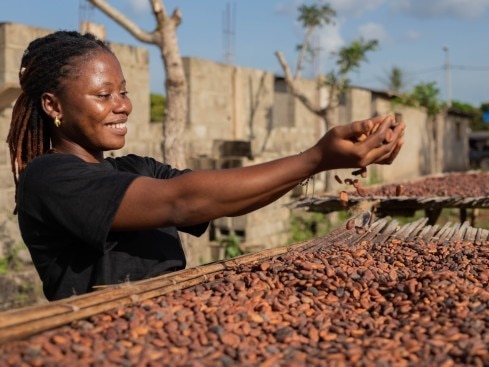

But what does this have to do with sustainable cocoa?
Glad you asked, time to get into the details. We’ve done a lot with the Nestlé® Cocoa Plan since 2009 and of course, we’ve learnt a lot too. These solid foundations allowed us to launch the innovative income accelerator programme and our ambition is to improve the livelihoods of cocoa-farming families.
The program rewards cocoa-farming families not just for the quantity and quality of their cocoa beans, but also for practices that can benefit the environment and local community. So far, the program has been rolled out to 10,000 cocoa-farming families (and counting) in Côte d’Ivoire. It doesn’t stop there though! This is a step on the road with the ambition to expand the program’s reach even further. First by extending our coverage in Côte d’Ivoire and entering in Ghana and then aiming to reach 160,000 cocoa-farming families in our supply chain by 2030.
The cocoa mass we use in our “Breaks For Good” KitKat® bars comes from the income accelerator programme and is traceable from the group of farmers right through to our KitKat® factories in Hamburg and Sofia.
What does that mean?
This is the exciting part. One way to think of it is that the cocoa beans from the program are isolated from the other beans to guarantee full segregation. It is like if they were travelling with a sort of virtual passport, which gets stamped at every stage of the cocoa's journey.
In this way we know that the cocoa mass in your KitKat bar has come from this innovative programme and can assure it has been sustainably sourced, including a Rainforest Alliance certification. This is a first step towards full segregation of our cocoa ingredients as we continue working with our suppliers to increase segregated volumes and building on the expansion of the income accelerator program.
Pictures are worth a thousand words, right? So, this might explain it better:

Breaks and incentives coming together
You’re here because you’ve scanned the unique QR code on your KitKat (or googled it). We’re glad you did because now we can tell you all about the good your break is helping to do!
See that KitKat you’re currently munching on? It’s part of an innovative program that aims to increase the income for cocoafarming families in Côte d’Ivoire.
Our income accelerator program takes a unique family-centred approach, with the ambition to deliver real and long-lasting impact to cocoa-farming families’ lives and futures. This innovative program rewards cocoa-farming families for practices that not only help them increase their income, but also benefit the local environment and their community.
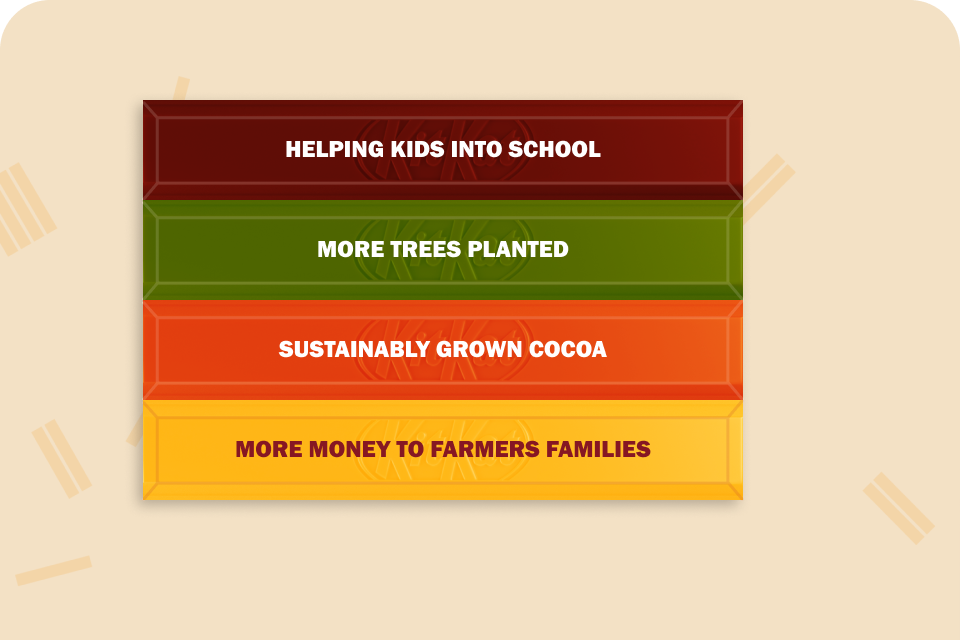
Four-fingers, four pillars
Just like the four-fingers in a KitKat, we have four pillars that bring the income accelerator program to life. These four pillars are centred around good practices and if all are achieved, cocoa-farming families can earn up to 500 euros in extra income a year:
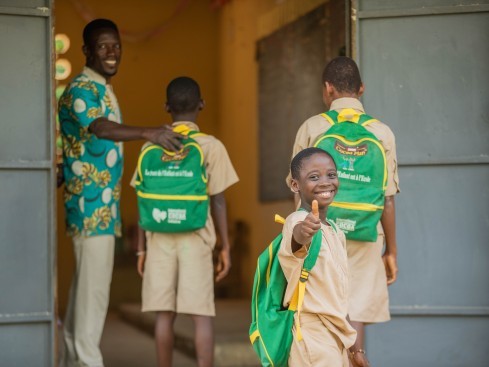
1. Helping children from the community, aged 6 – 16, into school.
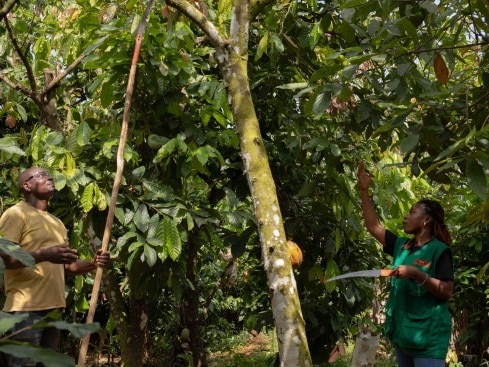
2. Improving the way farming is done, such as pruning, to increase crop productivity.
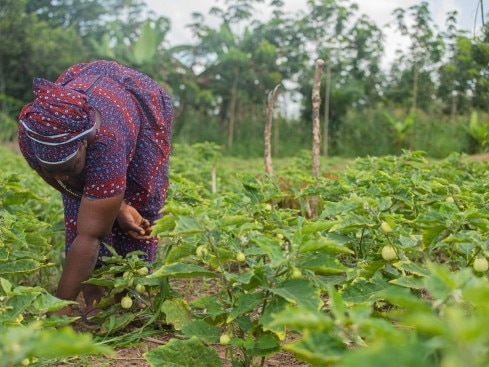
3. Planting forest and fruit trees on cocoa farms, which helps cocoa trees resist climate change and adds income for the farmers.

4. Empowering women to start businesses. This can include growing other crops; raising livestock such as chickens, beekeeping, or selling vegetables from community led gardens.

How are these incentives paid?
We pay these incentives directly into the hands of the cocoa-farming families. In fact, we snap it in two – half to each head of the household. This way, the incentives contribute towards gender equity and are more likely to be reinvested in education and community benefit.
By offering immediate financial benefits through these incentives, our ambition is to create an environment that enables cocoa-farming families to build a better life for themselves and future generations. You could say that we’re not just trying to make the world sweeter but help make it brighter too.
So far, we are working with 10,000 cocoa-farming families (and counting) in Côte d’Ivoire through the income accelerator program. And it doesn’t stop there, this is a step on the road to expand the program’s reach to Ghana and actively work to help 160,000 cocoa-farming families by 2030.










